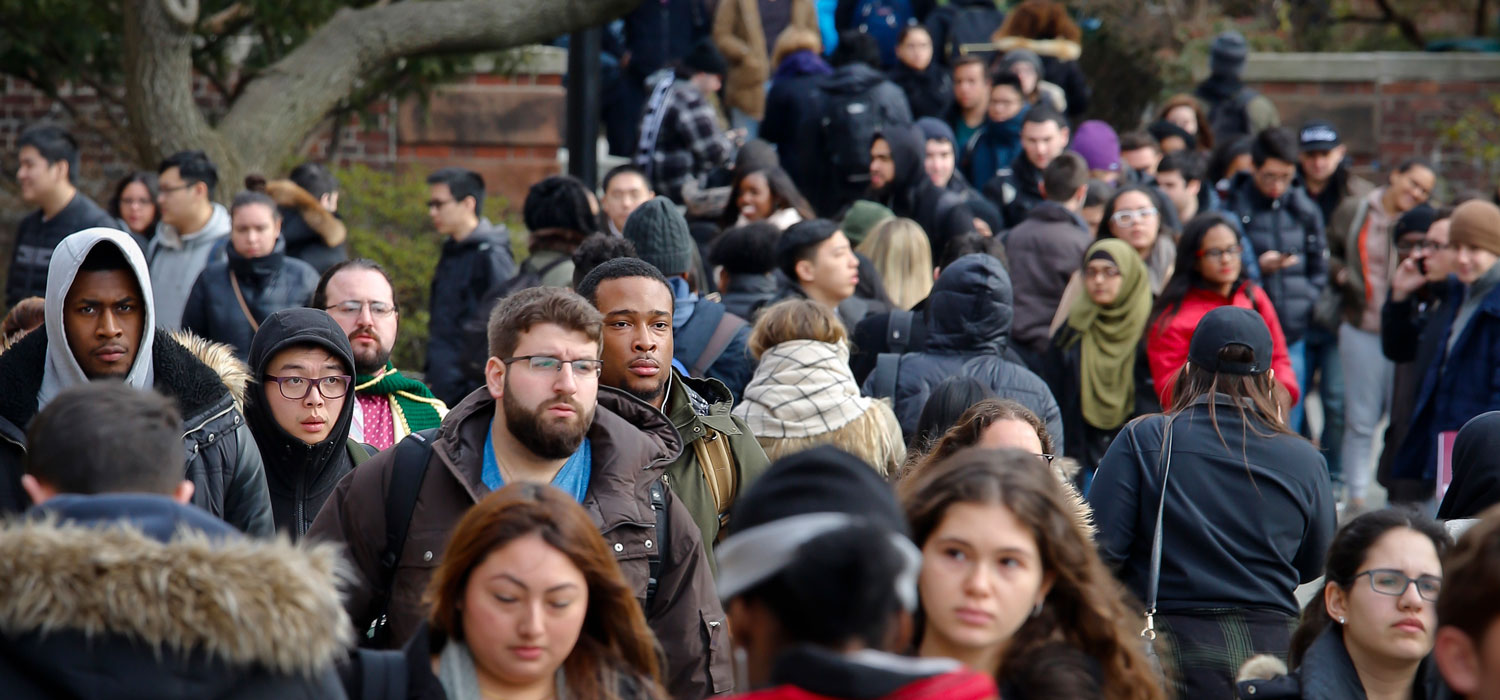
<p>Brooklyn College students walk between classes on campus in New York on Wednesday Feb. 1, 2017. Photo by Bebeto Matthews/AP.</p>
Due to coding errors, a previous blog post on this topic, published January 22, 2018, was retracted on May 1, 2019. We corrected those errors, ran the numbers again, and wrote the following new analysis. To read an explanation of how the errors occurred—and to see a detailed explanation of which numbers have changed—click here.
This post was corrected on May 20, 2019, to fix an error that was held over from the retracted post. The share of households with education debt who are in the lowest income quartile is 17 percent, not 14 percent, as originally reported.
Sen. Elizabeth Warren’s (D-MA) recent proposal to forgive a significant portion of student debt might be among the more generous plans, but Warren is certainly not the first to propose student debt forgiveness as a solution to the perceived student loan crisis—and it’s unlikely she’ll be the last. But to understand whether these proposals help those most affected by student debt, it helps to understand who holds that debt.
Many students, especially those who enroll in college but leave school without completing a credential or those who complete programs at institutions that don’t prepare them to find good jobs, face real problems with student debt. But these problems do not mean that most student loan borrowers are less well off than those without student debt—in fact, most outstanding student debt is held by people with relatively high incomes.
According to our updated analysis of the Survey of Consumer Finances for 2016 (the best available data, though imperfect), the most affluent households—the top 25 percent of households with the highest earnings—held 34 percent of all outstanding education debt. The top 10 percent of households, with incomes of $173,000 or higher, held 11 percent of the debt.
This debt represents loans for both current and past students and is a combination of students borrowing for their own education and parents or grandparents borrowing to help their children or grandchildren pay for college.
Households in the lowest income quartile (with household incomes of $27,000 or less) hold only 12 percent of outstanding education debt. In other words, education debt is disproportionately concentrated among the well off.

These analyses, consistent with other findings, suggest that debt forgiveness plans would be regressive—providing the largest monetary benefits to those with the highest incomes.
Information on outstanding debt is based on where borrowers are after they have financed their college education, not where they started out. Those with the highest incomes hold the most education debt because more education frequently means more debt, but it usually also means higher earnings.
In 2016, according to the US Census Bureau, median earnings for full-time workers ages 25 to 64 ranged from $30,000 for adults who did not complete high school and $37,000 for those with a high school diploma to $46,000 for holders of an associate’s degree and $62,000 for those whose highest degree was a bachelor’s degree. Adults with advanced degrees earned considerably more.
As you might expect, those who earn more owe more. The average household in the lowest income quartile with education debt owes $26,000. The average household in the top 10 percent of the income distribution with education debt owes $46,700.

People in the lowest income quartile tend to have little or no college education. Those in the top income quartile are most likely to have at least a bachelor’s degree. They paid for more education than those who are now less well off. The education many of them borrowed to pay for is also what helped them rise toward the top of the income distribution. In fact, 48 percent of outstanding student debt is owed by households with graduate degrees.
But the fact that a relatively small share of outstanding education debt is held by low-income households does not mean that these households have not borrowed. The bottom income quartile includes a larger share of the borrowers than of the debt. Seventeen percent of the households with education debt are in this income bracket. And although they may not hold large amounts of debt, 42 percent of those with education debt have an associate’s degree or less. For these households, even lower-than-average debt levels can cause financial strain.

The concentration of education debt among the relatively affluent means that some policies designed to reduce the burden of education debt are actually regressive. Focusing on lowering the interest rates on all outstanding student debt or on forgiving large amounts of that debt would bestow significant benefits on relatively well-off people.
Protecting households struggling with student debt through such policies as income-driven loan repayment plans, in which more than a quarter of all student loan borrowers now participate, is important. And it’s important to consider ways to mitigate the problem on the front end, whether by increasing grant aid, enforcing stricter accountability requirements on colleges, or finding other ways to ensure the most vulnerable households don’t take on debt they can’t afford.
But targeting the households who are struggling the most financially requires looking beyond who owes the most.